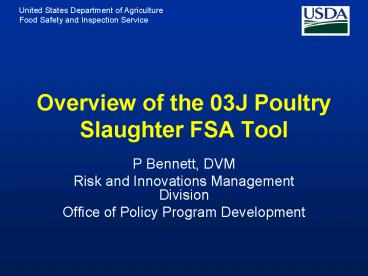Overview of the 03J Poultry Slaughter FSA Tool PowerPoint PPT Presentation
1 / 12
Title: Overview of the 03J Poultry Slaughter FSA Tool
1
Overview of the 03J Poultry Slaughter FSA Tool
- P Bennett, DVM
- Risk and Innovations Management Division
- Office of Policy Program Development
2
Reasons for collecting this information
- To provide the information needed for FSIS to
identify a food safety systems risks relative to
other establishments - Support enforcement recommendations
3
03J Poultry Slaughter FSA Sections Include
- Pre-Harvest
- Live Receiving
- General Processing
- Scalding
- Picking
- Evisceration
- Reprocessing
- Chilling
- Validation
- General Microbial Testing
- Antimicrobial Processes
- Generic E. coli
- Salmonella
4
Pre-Harvest
- For informational purposes only
- Not to be used as justification for regulatory
action - Voluntary
- Used by FSIS to populate risk-based models, i.e.
Predictive Analytics - Used to inform Agency guidance and policies, not
solely for Salmonella PFGE
5
Live Receiving
- EIAO will observe and evaluate how practices at
live receiving influence in-plant food safety
systems and decisions by asking questions such
as - Does the establishment know the type and level of
incoming pathogens? - Do live receiving practices influence (negatively
or positively) risk of biological food safety
hazard being introduced? - Are the machines kept in good repair to ensure
consistent and effective processing?
6
Scalding, Picking, Evisceration
- EIAO will ask questions and make observations to
assess implementation of procedures - Does the establishment have parameters, or best
practices they follow to maximize a decrease in
pathogen load in scalding, picking, and
evisceration? - How does the establishment react to changes or
variations occurring within these process steps,
or evaluate effects on other areas?
7
Reprocessing, Chilling
- EIAO will observe and evaluate interventions and
antimicrobials used at these steps - Does the establishment use on-line reprocessing,
and if so is it used in food safety system
decision making? How? What type of system is
used? - Does the establishment rely solely on
chlorination in the chiller to decrease
Salmonella?
8
Validation
- EIAO will verify that establishments have
validated that their Salmonella program is
effective - Does the establishment know its pre-control and
post-control level of microbial contamination? - Does the establishment use process mapping or
line profiling to measure Salmonella loads?
9
Antimicrobial Processes
- EIAO will review use and support for use of
antimicrobials, and whether they are CCPs - What type of antimicrobial processes are used in
the slaughter system? Were they included in the
validation of the food safety system? Are there
times they are not used? - Do the products have residual effects? Is there
history of accidental increase in concentration
of antimicrobial on product?
10
Generic E. coli
- EIAO will review establishments generic E coli
sampling program - Does the establishment have written generic E.
coli procedures? Are they followed? - If the establishment exceeds m/M criteria, how do
they react?
11
Salmonella
- EIAO will review Salmonella testing history
- What Salmonella category is establishment
currently in? - Does the establishment review FSIS sample results
as they are made available? - Does the establishment conduct in-house
Salmonella testing?
12
Animal Drug and Biological Residues
- EIAO will review establishments residue program
- Has the establishment identified residues as a
hazard likely to occur? - Does the establishment have an animal
identification system adequate for traceback? - Has the establishment received a warning letter
from FSIS for violative levels of residues?

